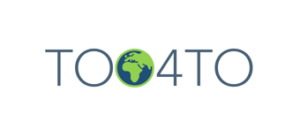Fast Fashion is out of Fashion. Reusability – New Trend in the Textile Sector
The textile and apparel sector is of high importance and complexity. The transition to more sustainable and circular textile systems affects various stakeholders through the whole value chain and life cycle of the product. The EU is concerned about those challenges, and therefore the corresponding strategies and regulations are developed in order to guide the stakeholders. This paper is oriented to light upon the reuse as an option of the extension of the life cycle of the products. What kind of transformations are needed in order to make it effective and scalable as a promising tool for the circularity of the sector?
EU consumption of textiles is mostly based on imports. It has a significant negative environmental impact: the 4th on climate change and the 3rd on water and land use from a life-cycle perspective (EEA, 2022). 5.8 million tons of textiles are discarded in the EU each year, approximately 11 kg per person per year (EEA, 2019). Landfilled or incinerated textile results in huge losses of textile primary resources. It also leads to losses related to production processes because of the usage of millions of tons of water and kilowatts of energy, and work hours (Aus et al., 2021). In solving the problems of the waste sector, the EU has determined that every member state must introduce a separate collection system for textiles from January 1, 2025 (2008/98/EC, 2018), in order to reduce the amount of textiles to be landfilled as waste and promote their recycling and reuse rates.
Up to 2.1 million tons of second-hand clothing and textiles are collected separately for recycling or reuse in the EU each year, representing around 38% of all textiles placed on the EU market (JRC 2021). It varies considerably in the EU member states, e. g. 5% of used textiles are collected in Latvia, respectively 11% in Lithuania and Italy, 30% in Estonia, 40% in Norway, 42% in Denmark and 70% in Germany. The rest of the textile products are discarded as mixed municipal waste for landfilling and/or incinerated (Nordic, 2020; Sandin & Peters, 2018).
However, the collection of used textiles (as waste) separately does not ensure higher recoverability or lower environmental impact. Organizations operating in the used textile collection sector report that there is a small share of textile products suitable for the reuse market. Meanwhile, there is a huge lack of recycling technologies and a market for low-quality textiles (Nordic, 2020). The development of recycling technologies and the implementation of national or international systems is a long-lasting process. Therefore the life cycle extension strategies are getting more and more relevant in the EU market in order to foster the transition towards circular textile systems.
According to the (WRAP, 2017) report, the reuse of textile is the most popular in Denmark, where 17% of the population try out second-hand market options before buying new clothes. However, the EU Waste Prevention Report (EEA, 2018) shows that the average reuse rate is below 9% in Denmark and below 5% in other EU countries.
The European Commission adopted the EU strategy for sustainable and circular textiles (Strategy) in March 2022, addressing environmental, waste and social challenges in this sector and opportunities for more sustainable development. The Strategy recognizes that extension of the textile lifetime is the most effective way to significantly reduce its negative impact (EC, 2022). The strategy seeks to solve the current situation of consumption patterns: consumerism and decreased quality of apparel. The main reasons why consumers discard textiles are the low quality of clothes and short usability. The fast fashion trend includes mass production of garments, quickly responding to the latest fashion trends and enticing consumers to keep buying at low prices.
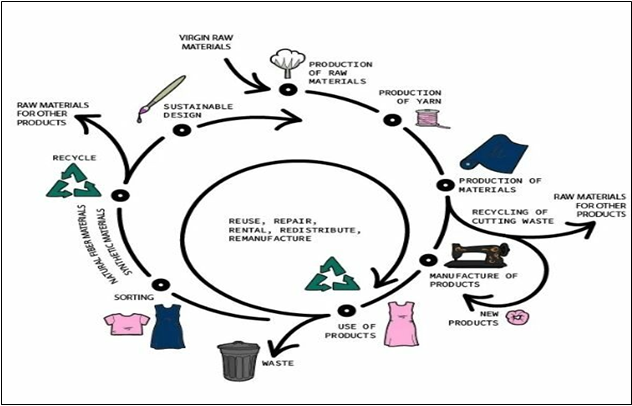
As indicated in the strategy and proved by the researchers, the most important instrument for the extension of textile products’ lifetime (fig. 1) is prevention based on the Eco-design Regulation for Sustainable Products (Regulation). The design of product determines up to 80% of its life-cycle environmental impact (Commission et al., 2014) and based on the following regulation requirements products will be more sustainable, reliable, reusable, upgradeable, repairable, maintainable, refurbishable, recyclable and energy, resource and socially efficient (European Commission, 2022b).
The production, consumption and extension of the life cycle of sustainable textiles will gain meaningful benefits through the whole value chain of textile products by the introduction of a digital product passport. The main aim of it is to collect and provide valuable data on a product’s environmental performance and its suitability for reuse, repair, recycling and other circular options. Application of the extended producer responsibility (EPR) principle expected in the Strategy would oblige producers and suppliers to the EU market to take responsibility for the textile waste they generate, resulting in an additional need on the part of the producer to find solutions for sustainable product design, new recycling technologies and wider reuse activities, thus ensuring the prevention of textile waste and the longest possible use of textiles as products. EPR systems for textiles are active in two EU Member States: France (since 2008) and Sweden (since the beginning of 2022). EPR for textiles will start in the Netherlands in 2023. However, the EU is supposed to provide consolidated guidelines for all of the EU.
The Textile Strategy also focuses on strengthening responsible consumption and awareness among consumers so that the demand for sustainable textiles would increase not only from the political strategies and regulations but also from the consumers’ “bottom-up” intentions. The Strategy facilitates the development of responsible consumption behaviour by implementing the following measures: manufacturers publicly disclose information on how they dispose the unsold or returned textiles; using only credible eco-claims and correct eco-labelling and considering the introduction of a digital label; the provision of information to the consumer at the point of sale on the products’ commercial durability guarantee, reparability level, etc.
Although the Strategy was adopted on March 30, 2022, the transition towards a sustainable textile economy has already begun quite efficiently. 12.5% of the fashion industry is committed to circular fashion, and many leading retailers have set bold targets and increased consumers’ awareness about fashion’s environmental impact (Global Fashion Agenda, 2018). Thus, the decoupling is on the process in different stages of the value chains: starting from the resources’ use when the textile industry is looking for solutions for new-garment designs, sustainable materials, and advanced recycling technologies, but also implementing new circular business models that are reuse-oriented (Fashion for Good & Accenture., 2019) (figure 2). The circular business models (renting, end-of-life collection services, second-hand clothing collections, resale, repair, remaking, etc.) aim to optimize the life cycle stage of usage and provide more opportunities for textile products to be reused after the primary use phase (UNEP, 2020).
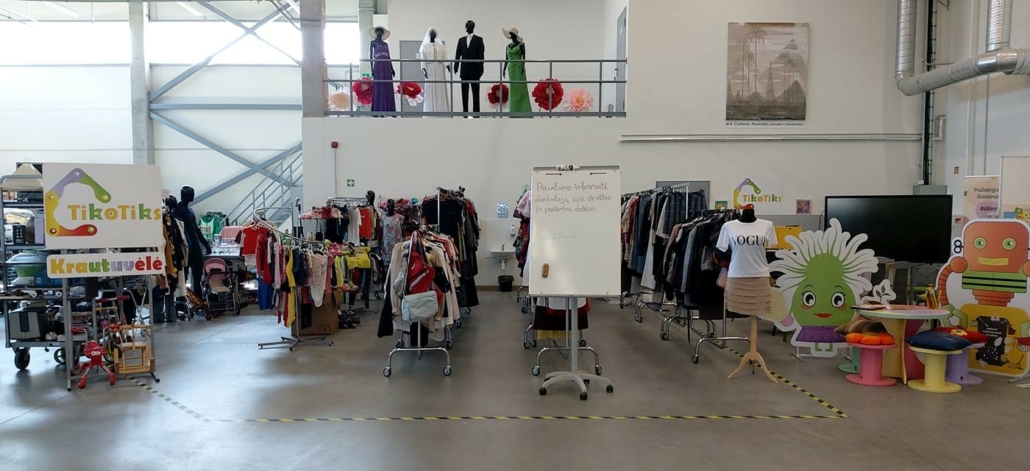
A study by the Ellen MacArthur Foundation (Ellen MacArthur Foundation, 2021) found that the global value of reuse businesses in 2019 was 73 billion USD (figure 3), and it represented 3.5% of the global fashion market revenues. It was estimated that the share of the reuse market could increase up to 23% of the fashion market (USD 700 billion) by 2030. It would lead to a 16% reduction in greenhouse gas emissions. The study estimates that these business models will grow faster in Europe and North America and could account for around 43% of total fashion market revenue in Europe by 2030.
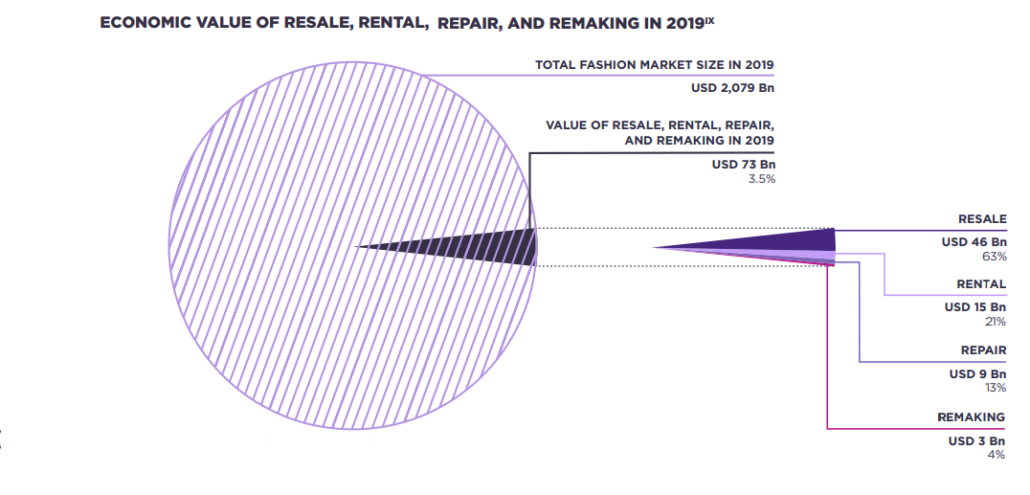
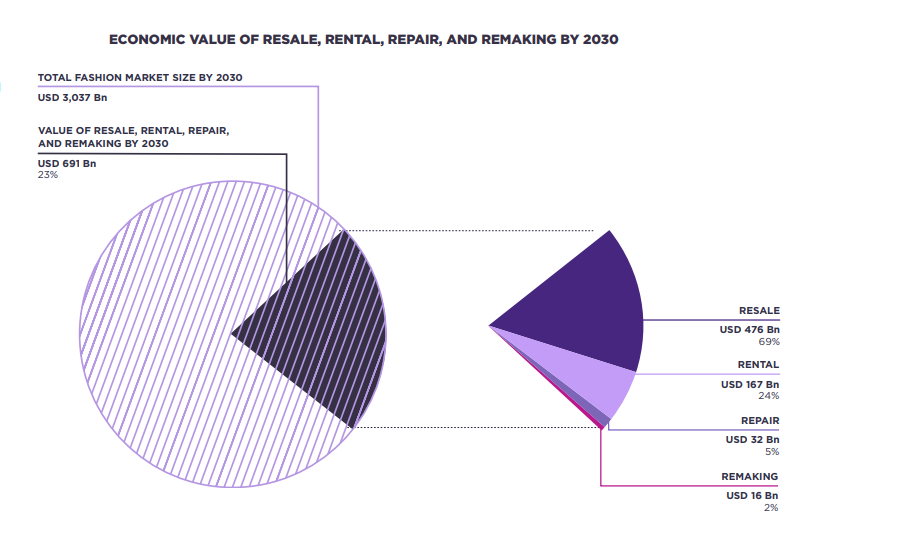
After a brief overview of textile waste prevention in the context of reuse, the Textile Strategy will be one of the key documents guiding the direction and means of building a sustainable and circular textile economy. Inspired by eco-design requirements and the application of producer responsibility, the textile industry will stimulate and influence the search for innovative alternatives to prolong the product life cycle, which will allow the expansion of existing textile reuse models and the creation of new ones. Reuse is a much more promising strategy, which will be supported by the EU and national institutions. Therefore, investing in the textile service and reverse logistics activities is an opportunity for the various stakeholders within the value chain and their cooperation. The consumers and environment will gain many positive effects out of this transformation from fast fashion towards the extension of the usage of higher quality textile products and services.
Written by Agnė Jučienė, Inga Gurauskienė, Institute of Environmental Engineering, KTU, Lithuania
References:
2008/98/EC. (2018). Directive 2008/98/EC of the European Parliament and of the Council of November 19, 2008 on waste and repealing certain Directives (Text with EEA relevance). https://eur-lex.europa.eu/legal-content/EN/TXT/?uri=celex%3A32008L0098
Aus, R., Moora, H., Vihma, M., Hunt, R., Kiisa, M., & Kapur, S. (2021). Designing for circular fashion: integrating upcycling into conventional garment manufacturing processes. https://doi.org/10.1186/s40691-021-00262-9
Commission, E., Energy, D.-G. for, & Industry, D.-G. for E. and. (2014). Ecodesign your future: how ecodesign can help the environment by making products smarter. European Commission. https://doi.org/doi/10.2769/38512
EEA. (2018). Waste prevention in Europe — policies, status and trends in reuse in 2017. https://doi.org/doi:10.2800/15583
EEA. (2019). Textiles and the environment in a circular economy.
EEA. (2022). Textiles and the environment: the role of design in Europe’s circular economy. https://www.eea.europa.eu/publications/textiles-and-the-environment-the
The Ellen MacArthur Foundation. (2021). Circular business models: Rethinking business models for a thriving fashion industry. https://ellenmacarthurfoundation.org/fashion-business-models/overview
European Commission. (2022a). EU Strategy for Sustainable and Circular Textiles. COM (2022) 141 Final. https://eur-lex.europa.eu/legal-content/EN/TXT/?uri=CELEX%3A52022DC0141
European Commission. (2022b). On making sustainable products the norm COM (2022) 140 final. https://eur-lex.europa.eu/legal-content/EN/TXT/?uri=CELEX:52022DC0140
Fashion for Good & Accenture. (2019). Driving circular business models in fashion. https://fashionforgood.com/wp-content/uploads/2019/05/The-Future-of-Circular-Fashion-Report.pdf
Global Fashion Agenda. (2018). 2020 Commitments. https://www2.globalfashionagenda.com/commitment/#
Nordic. (2020). Post-consumer textile circularity in the Baltic countries: current status and recommendations for the future.
Sandin, G., & Peters, G. M. (2018). Environmental impact of textile reuse and recycling – A review [Article]. Journal of Cleaner Production, 184, 353–365. https://doi.org/10.1016/j.jclepro.2018.02.266
UNEP. (2020). Sustainability and Circularity in the Textile Value Chain: Global Stocktaking. https://wedocs.unep.org/20.500.11822/34184
WRAP. (2017). Mapping clothing impacts on Europe: the environmental cost. http://www.ecap.eu.com/wp-content/uploads/2018/07/Mapping-clothing-impacts-in-Europe.pdf
www.circularstories.org. (2022). circularstories.org. https://circularstories.org/009-circular-fashion-berlin-startup/
